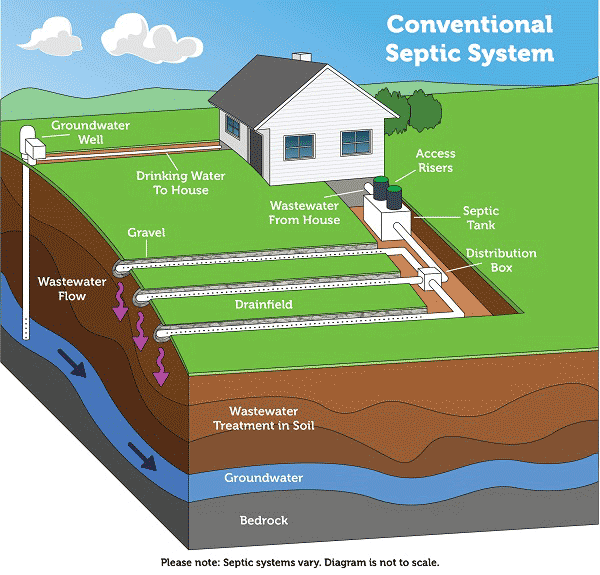Save Our Indian River Lagoon on Septic Systems
The Save Our Indian River Lagoon Program is often asked how harmful septic systems are to the Indian River Lagoon.
In a conventional septic system, wastewater enters the septic tank where solid materials sink to the bottom and grease and fats float to the top. In between those layers is a pipe that transports all the liquid sewage and disperses it directly into the soil of a drain field. If the drain field is high enough above the groundwater table, then microbes in the soil will have time to kill pathogens, bacteria, and viruses before the effluent reaches the groundwater.
Though conventional septic systems protect human health, they do not stop nutrients that pollute the water and feed algae blooms. Only 10-40% of nitrogen in wastewater is removed by a properly operating conventional septic system. The remainder is transported to the groundwater which flows into the Indian River Lagoon (IRL). Systems with leaks or insufficient separation from the groundwater table are even more polluting. Higher levels of pollution can enter the lagoon from failing or older systems.

There are over 53,000 septic systems in the IRL watershed in Brevard County. They treat over 1 billion gallons of sewage a year, which contributes nearly 400,000 pounds of nitrogen pollution to the lagoon each year. That makes septic systems the third largest source of new nitrogen pollution to the Indian River Lagoon.
The Save Our Indian River Lagoon (SOIRL) program is working to reduce septic pollution affecting the lagoon by funding the extension of sewer lines, removal of septic systems, and providing homeowners monetary assistance to hook up to a sewer system.
In areas where homeowners cannot connect to a sewer system, SOIRL has a grant program that provides homeowners and businesses up to $18,000 to upgrade their conventional septic system to an advanced treatment system rated by the state to remove at least 65% of the nitrogen. The most common advanced systems are nitrogen reducing Aerobic Treatment Units (ATU).
Since 2018, all new construction on the barrier island or close to the lagoon is required to connect to sewer or install a nitrogen-reducing advanced septic system. Effective July 1, 2023, all current septic systems in the lagoon watershed must either hook up to sewer or upgrade to a nitrogen-reducing advanced septic system by 2030.
For those on septic systems, it is important to keep your system running optimally. In addition to getting regular pump-outs and inspections, septic owners need to know what can and cannot go down the sink, and how to properly care for your tank and drain field. Learn more about how to keep your septic system at peak performance with the following informational videos:
Visit SOIRL’s Lagoon Loyal website to learn about other tips and actions you can implement around your home to further help reduce pollution in the Indian River Lagoon. Find out more about the plan and projects being done with the ½ cent sales tax on the SOIRL website. Or if you have questions email SOIRL at IRLProject@BrevardFL.gov.